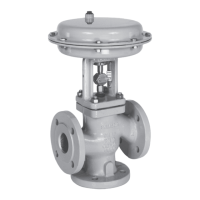EB 8026 EN 25
Mounting and start-up
− Remove the mounted actuator before
mounting the other actuator (see associat-
ed actuator documentation).
− Preloading the actuator springs increases
the thrust of a pneumatic actuator and re-
duces the travel range of the actuator (see
associated actuator documentation).
5.2 Installing the valve into the
pipeline
5.2.1 Checking the installation
conditions
Pipeline routing
The inlet and outlet lengths vary depending
on the process medium. To ensure the control
valve functions properly, follow the installa-
tion instructions given below:
Î Observe the inlet and outlet lengths (see
Table5). Contact SAMSON if the valve
conditions or states of the medium pro-
cess deviate.
Î Install the valve free of stress and with the
least amount of vibrations as possible. If
necessary, attach supports to the valve.
Î Install the valve allowing sufcient space
to remove the actuator and valve or to
perform service and repair work on
them.
Î In heating or cooling applications, the
valve can be installed in the ow pipe or
return ow pipe (see Fig.6).
Mounting position
Generally, we recommend installing the
valve with the actuator upright and on top of
the valve.
In the following versions, the valve must be
installed with the actuator on top:
− Valves in DN100/NPS4 and larger
− Valves with insulating section for low
temperatures below –10°C (14°F)
Î Contact SAMSON if the mounting posi-
tion is not as specied here.
Support or suspension
Depending on the valve version and mount-
ing position, the control valve and pipeline
must be supported or suspended. The plant
engineering company is responsible in this
case.
Premature wear and leakage due to insuf-
cient support or suspension.
In the following versions, the control valve
must be supported or suspended:
− Valves that are not installed with the actua-
tor in the upright position on top of the
valve.
Attach a suitable support or suspension to
the valve.
Note
NOTICE
!

